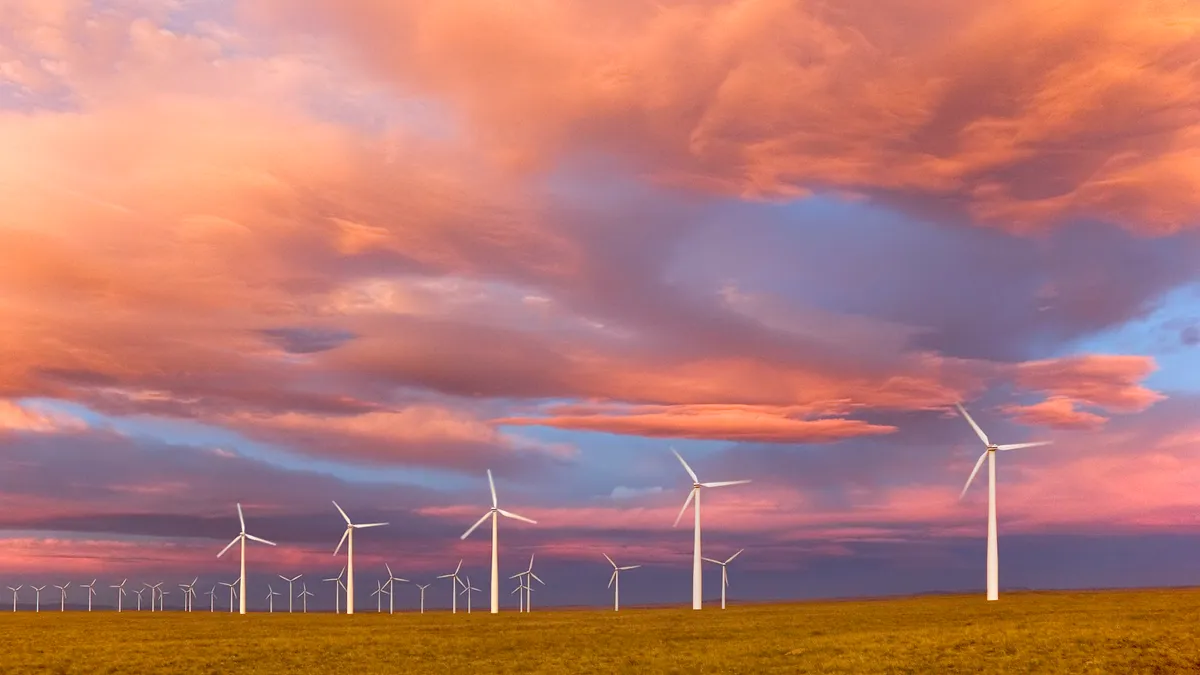New numbers from the Department of Energy put U.S. wind’s share of the country’s electricity production in 2020 at 10%, up from 2013’s 4.5%.
The draft Wind Vision Study projects 20% of the nation’s electricity coming from wind in 2030 and foresees wind becoming more than a third of the U.S. electricity supply by midcentury.
“Wind has done a lot of things that many would have argued in 2008 were unachievable,” said DOE Director of the Office of Wind & Water Power Technologies Jose Zayas in explaining why he calls the new vision “an aggressive yet credible scenario.”
In 2008, the U.S. wind industry had installed 25 gigawatts in 29 states at an installed price of $0.07 per kilowatt-hour. DOE’s projection for 2013 at that time foresaw an installed capacity of 48 gigawatts in 35 states and a price of $0.066 per kilowatt-hour, Zayas said. The 2013 reality was 61 gigawatts of installed capacity in 39 states and a price of $0.045 per kilowatt-hour.
The draft Wind Vision Study is the product of work by over 100 private companies and public agencies and is scheduled for official release in early 2015. It estimates the U.S. wind resource at “more than 10 times our current electric sector capacity.” Its numbers are based on harvesting “less than 5%” of that.
The big numbers
The study projects that by 2020, the installed capacity of U.S. wind will be 113 gigawatts, with 110 on land and 3 offshore. The 2030 total will be 220 megawatts, with 200 on land and 20 offshore. By 2050, the U.S. will have a 405 gigawatt installed wind capacity, with 320 on land and 85 offshore.
What the Wind Vision Study foresees “is a steady growth of 7 gigawatts per year through 2020, followed by 12 gigawatts per year between 2020 and 2030,” explained Terra-Gen Power Government Affairs VP Gregory Wetstone. “That’s a big order. But the industry has been largely on that path. If we can secure the right kind of policies, we can get there.”
“Getting from where we are today to where we need to be will not be easy,” Zayas said. “There are a lot of things that have to happen.”
The study shows cost reduction pathways from now through 2050 for land based and offshore wind, Zayas explained. Given different variables, those costs can be higher or lower. The study attempts to provide clarity about where the industry must focus to get the more aggressive cost reductions “because cost so strongly impacts deployment.”
The Wind Vision study describes 3 broad areas of action: Reduce the cost of wind, expand developable areas, and increase the economic value to the nation.
Transmission
In the “expand developable areas” category, Zayas said, transmission is a key. Required transmission additions are estimated at approximately 900 circuit miles per year in the 2020s and approximately 1,100 circuit miles per year from 2031 to 2050. This is about the average 850 circuit miles to 900 circuit miles per year built in the U.S. since the early 1990s and the 3,800 circuit miles now under construction, the study reports.
The projected cost for that transmission expansion is an estimated at $4 billion per year, slightly less than the $4.3 billion per year currently being spent on new transmission, according to PJM Vice President Andrew Ott. “And there are no engineering or technical obstacles. Only siting and permitting would limit the necessary growth.”
“What we all acknowledge in the environmental community is the reality of climate change,” replied Defenders of Wildlife President andCEO Jamie Rappaport Clark. “Our renewable energy future and the long term conservation of our rich wildlife heritage are flip sides of the same coin. Finding pragmatic solutions for wind development is very important.”
“There are challenges,” Zayas said. “But we have a track record of being able to meet them.”
The costs and benefits
Further projections from the draft study, all still subject to revision, include:
- Cumulative savings through 2050 of $149 billion will come from reduced fossil fuel purchases that cut power system capital costs, operations and maintenance costs, and fuel costs in power sector generation, storage, and transmission
- Electricity rates through 2030 increase just under 1%, but that build-out provides significant “quantified, monetized social benefits” in return, Zayas said. By 2050, rates are expected to drop $0.003 per kilowatt-hour, a 2% savings for ratepayers.
- The cumulative 2013 through 2050 reduction of 12.3 gigatons of carbon dioxide equivalent, producing a savings of $400 billion in averted damage from global climate change.
- The reduction in other air pollutants prevents 22,000 premature deaths through 2050 and saves $108 billion in avoided health and economic damages.
- Water use is reduced 4% by 2020, 11% by 2030 and 23% by 2050.
- Increased wind puts downward pressure on natural gas prices and makes the total electricity system an estimated 20% less sensitive to natural gas price fluctuations, resulting in a $280 billion savings for electricity consumers by 2050.
The final question
The last question is how to tell the story in a way that builds support and the study tries to articulate that, Zayas said. “Wind deployment can provide U.S. jobs, U.S. manufacturing, and lease and tax revenues in local communities to strengthen and support a transition towards a low-carbon economy,” it concludes.
Yearly lease payments to landowners for allowing wind development on their property grow from $350 million in 2020 to $650 million in 2030 and $1 billion in 2050, the study reports. And yearly taxes paid to local communities grow from $900 million in 2020 to $1.7 billion in 2030 and $3.2 billion in 2050.
With the fall of coal and nuclear, with possible limits on shale gas supplies, and with the skyrocketing rise of solar, a veteran wind industry researcher pointed out to Utility Dive informally, wind could be the leader in the U.S. energy mix by mid-century.
“The days when wind was thought of as a boutique industry are gone,” Zayas said.





















